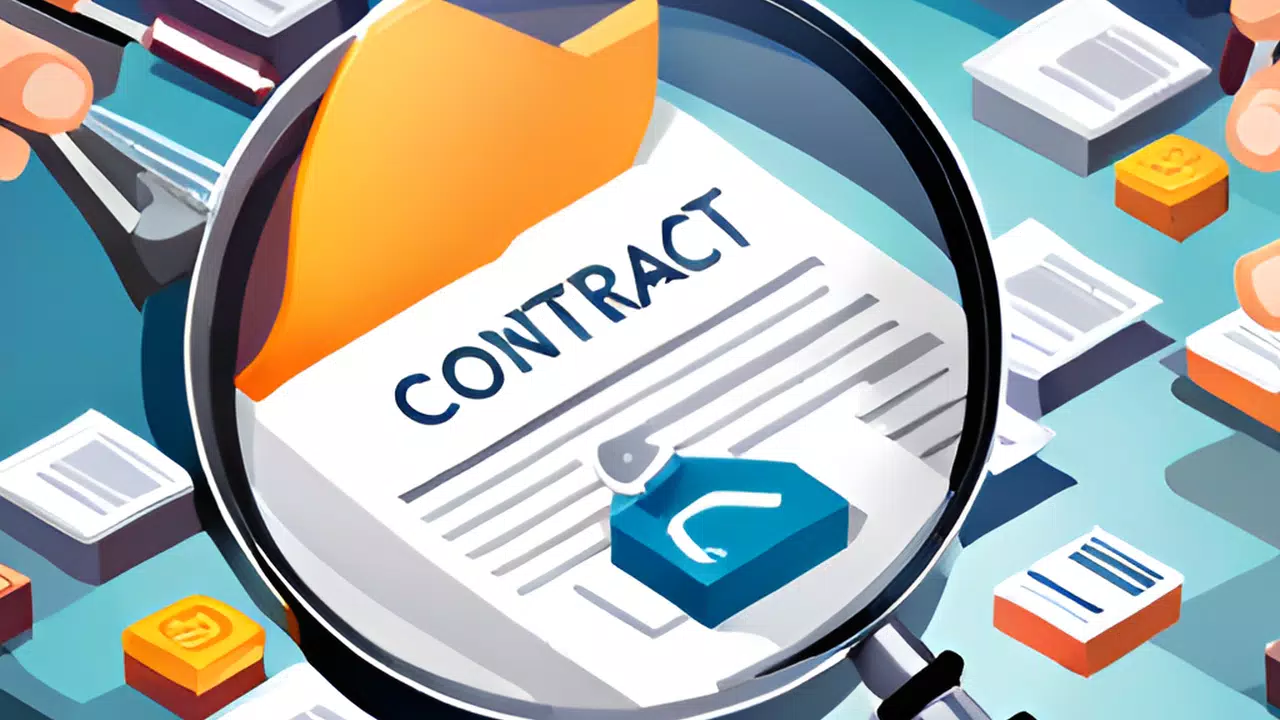
Understanding the Fundamentals of Contract Creation
Contracts are the backbone of business relationships, helping to establish trust and clearly define expectations between parties. Drafting a great contract is essential for success, and it starts with understanding the fundamentals of contract creation.
Importance of Contracts in Business Transactions and Relationships
Contracts are essential in business transactions and relationships as they establish legally binding obligations and expectations between parties. They set out the terms and conditions of a deal, ensuring that everyone understands their responsibilities. A contract can also help to prevent disputes and misunderstandings.
According to a study by the International Association for Contract & Commercial Management (IACCM), almost nine out of ten companies experience contract-related issues. It is crucial for businesses to focus on the contract creation process to avoid these problems.
Essential Elements of a Contract
The essential elements of a contract are offer, acceptance, consideration, and legality. For a contract to be legally binding, there must be an offer by one party that is then accepted by the other party. There must also be a mutual understanding that one party will provide something of value, known as consideration, in exchange for something else.
The legality element ensures that the terms of the contract adhere to all applicable laws and regulations. Any illegal terms within a contract would render it unenforceable in a court of law.
Importance of Clear Communication and Mutual Understanding
Clear communication is key when drafting a contract. It ensures that both parties have a mutual understanding of their respective expectations and obligations. When there is a mutual understanding, the likelihood of both parties complying with the terms of the contract increases.
A study by PwC found that 48% of companies experienced communication-related disputes within their contracts. In some cases, these disputes led to time-consuming and costly litigation. Clear communication can help avoid such disputes and ensure both parties receive what they expect from the contract.
The Role of Good Faith
Good faith refers to a sincere intention to deal fairly and honestly with the other party in a contract. It is an essential element of contract creation. Parties entering into a contract must demonstrate good faith and honesty in their dealings with each other. If a party shows bad faith, then it could lead to the contract being unenforceable.
Significance of Written Contracts over Oral Agreements
In general, written contracts are preferable to oral agreements as they provide clear evidence of what was agreed upon. They help prevent misunderstandings, especially in complex business transactions. Written contracts also serve as a point of reference in cases of disputes between parties.
According to studies, written contracts are eight times more likely to be enforced in court than oral agreements. This is because they provide clear evidence of what was agreed upon and leave little scope for interpretation.
Importance of Consulting Legal Counsel
Consulting legal counsel is essential when creating a contract. This is because legal counsel has expertise in the creation and interpretation of contracts. They can help ensure that the contract complies with applicable laws and regulations.
Legal counsel can also help identify potential problem areas that parties may not have considered. This can help parties avoid disputes that may arise from the contract.
Adhering to E-A-T Principles
When creating a contract, it is important to adhere to the E-A-T (Expertise, Authoritativeness, Trustworthiness) principles. According to these principles, a good contract should be drafted by someone with relevant expertise in the subject matter (Expertise). The person or organization drafting the contract should be authoritative in the field (Authoritativeness). The content of the contract should be trustworthy, clear, and well-researched (Trustworthiness).
By adhering to these principles, parties can ensure that the contract is well-drafted and legally enforceable.
In conclusion, the creation of a solid contract is pivotal for business success. It is imperative that all parties involved possess a transparent comprehension of the fundamental components of a contract, emphasizing the significance of clear communication, shared understanding, and good faith. Adherence to E-A-T principles is also crucial. Furthermore, legal advice should be sought to guarantee the legal enforceability of the contract. By heeding these guidelines, businesses can forge contracts that foster trust, forestall disputes, and promote the seamless execution of transactions and relationships.

The Steps in Drafting an Effective Contract
Drafting an effective contract is a multi-step process that requires attention to detail and foresight. Following these steps will help ensure that your contract is clear, enforceable, and serves both parties' interests.
Determine if all parties are eligible to participate in a contract
A contract is only valid if all parties are legally eligible to participate. In most cases, this means that all parties must be of a certain age and have the legal capacity to enter into a contract. According to LegalMatch, legal capacity refers to an individual's ability to understand the terms of the agreement and its legal consequences. For example, a person with a mental disability may lack the legal capacity to enter into a contract. It is crucial to ensure that all parties are legally eligible; otherwise, the agreement will be invalid.
Define the consideration: what each party is exchanging in the agreement
Consideration refers to what each party is receiving or giving up in the agreement. This can take the form of money, services, or goods. According to RocketLawyer, without valid consideration, a contract is not enforceable. The consideration must be of value, and both parties must agree on it. The consideration should be clearly outlined in the contract.
Establish clear terms that outline the rights and obligations of each party
The terms of the contract should be clear and concise, outlining each party's rights and obligations. This includes specifying what actions each party will take, the consequences of breaching the agreement or failing to meet obligations, and the process for resolving disputes. Clear terms, as advised by Nolo, can help prevent misunderstandings and disputes in the future. It is crucial to review and ensure that the terms are equitable and reasonable for all involved parties.
Consider including a confidentiality clause if sensitive information is involved
If the contract involves sensitive information, such as trade secrets or personal data, consider including a confidentiality clause. This clause prohibits one party from sharing the information with third parties. According to UpCounsel, this clause can help protect sensitive information and prevent breaches of confidentiality.
Add dispute resolution and termination clauses to handle potential conflicts or changes in circumstances
Unexpected changes or conflicts can arise during the life of a contract. Dispute resolution and termination clauses help parties manage these situations. According to Lawpath, dispute resolution clauses outline how conflicts or disputes will be resolved, such as through mediation or arbitration, and termination clauses outline how the contract can be terminated if one or both parties do not meet their obligations.
Ensure the contract adheres to applicable laws and regulations
The contract should adhere to all applicable laws and regulations. According to LawDepot, this includes ensuring that the contract does not violate any laws or regulations, including state and federal laws. An attorney may be able to help ensure compliance with all applicable laws.
Sign and date the contract with all parties involved
Once all parties have reviewed and agreed to the terms of the contract, it is essential to sign and date it. According to LegalZoom, this demonstrates that all parties have agreed to the terms of the agreement, making it legally binding. It is important to have all parties sign and date the contract to avoid any misunderstandings later.
Drafting an effective contract is a critical aspect of any business deal. It ensures that all involved parties comprehend their rights and responsibilities and outlines a clear mechanism for dispute resolution. Adhering to these steps guarantees the contract's effectiveness and enforceability.

Best Practices for Clear and Precise Contract Language
A well-drafted contract should be easy to understand, yet precise enough to avoid ambiguity. Following best practices for clear and concise contract language can help minimize disputes and misunderstandings down the line.
Use plain English where possible without sacrificing enforceability or legal concepts
Contracts are legal documents, but that doesn't mean they have to be written in obscure or complicated language. In fact, using plain English where possible can help avoid ambiguity and make the contract easier to understand. According to a study by the Plain Language Association International, using plain language can reduce misunderstandings and errors by up to 80%. However, it's important not to sacrifice enforceability or legal concepts in the process. Some terms may require a specific legal definition to accurately reflect the parties' intent. Therefore, while it's important to keep the language simple and clear, it's equally important not to oversimplify important concepts.
Rely on active tense and precise words to convey the intended meaning.
Using active voice and precise language can help ensure that the intended meaning of a contract provision is accurately conveyed. Active voice places emphasis on the subject of the sentence, clearly indicating who is responsible for carrying out an action. Precise language helps define each party's obligations and rights unambiguously. For instance, using "shall" instead of "may" eliminates uncertainty about whether an action is mandatory or optional.
Familiarize yourself with common contract terminology and legal concepts
Familiarity with common contract terminology and legal concepts can be beneficial in ensuring that contracts are drafted accurately and effectively. It is important for those involved in contract drafting to be cognizant of legal terms of art, such as "indemnification" or "assignment," as well as any industry-specific jargon that may be pertinent. Understanding these terms can help ensure that a contract accurately conveys the parties' intent and avoids any potential ambiguity. Additionally, being aware of common legal concepts such as jurisdiction and arbitration can facilitate efficient resolution of any disputes that may arise from the contract.
Study advice from experts like Ken Adams and Bryan Garner on drafting clearly
Ken Adams and Bryan Garner are both experts in the field of legal drafting, with years of experience in writing clearly and concisely. Their advice is valuable to anyone involved in contract drafting. Ken Adams provides resources such as his book *A Manual of Style for Contract Drafting*, which outlines best practices for contract drafting, while Bryan Garner has published several books on legal writing and teaches legal writing courses. By taking the time to study their advice, contract drafters can improve their skills and better understand how to draft clearly.
Use tools like BriefCatch to review your work for clarity and consistency
Tools like BriefCatch can be extremely useful in reviewing contracts for clarity and consistency. BriefCatch scans a document for phrases that may be unclear or confusing, providing suggestions for how to rephrase them in simpler, more direct language. This can help ensure that a contract is easy to understand and avoids any ambiguity.
Continuously improve your grammar and writing skills through practice and education.
Improving your grammar and writing skills is an ongoing process. By continuously practicing your writing through mock contracts or other exercises, you can improve the clarity and precision of your writing over time. Additionally, taking classes or courses focused on legal writing or grammar can be extremely helpful in improving your skills.
Always review the entire contract after each revision to ensure all changes are understood
After making any revisions to a contract, it is important to review the entire document to ensure that all changes are understood. This can help avoid misunderstandings or disputes down the line. By taking the time to review the entire document, drafters can ensure that each provision accurately reflects the parties' intent and that there are no unintended consequences.
In conclusion, contracts play a pivotal role in both business and legal realms. To ensure their intentions are accurately conveyed, parties should adhere to best practices for clear and concise contract language. This includes employing plain English, favoring active voice, and selecting precise terminology. Familiarity with standard contract jargon and legal principles is also imperative. By heeding expert advice, utilizing tools like BriefCatch, and continually refining their grammar and composition abilities, those drafting contracts can enhance their craft. Regularly reviewing the entire document after each alteration is also crucial to maintaining clarity and enforceability.

Navigating Contract Negotiations and Counteroffers
Contract negotiations can be a complex dance of offers, counteroffers, and compromises. Understanding how to navigate this process effectively is crucial in reaching a mutually beneficial agreement.
The importance of preparation and research before entering negotiations
Before entering into any negotiation, it is essential to conduct thorough research and preparation. Negotiators must have a clear understanding of the industry they are operating in, their counterpart's goals and motivations, and their own position. Analyzing different scenarios and outcomes will provide negotiators with a clear idea of their best alternative to a negotiated agreement (BATNA). According to Harvard Law School, having a BATNA is essential in any negotiation as it provides negotiators with a clear idea of their negotiation limits. Preparation also involves setting clear goals, determining priorities, and identifying potential areas for compromise.
Strategies for presenting an initial offer that leaves room for negotiation
When making an opening offer, negotiators should be realistic and avoid going to extremes. The initial proposal should allow for negotiation while also setting the tone for the discussion. A high starting point may be seen as pushy or impractical, potentially resulting in a deadlock. According to Forbes, presenting a range of options that cater to both sides' interests is a wise strategy.
Handling counteroffers: when to accept, counter or walk away
Counteroffers are a common tactic in the negotiation process. Negotiators must carefully consider each counteroffer before responding. If the counteroffer is satisfactory, it should be accepted without delay to keep the negotiation process moving forward. If the counteroffer is unacceptable, negotiators should take the time to re-evaluate their position and consider making a counteroffer that better reflects their interests. If both parties cannot come to an agreement that meets their needs, walking away from the negotiation table is always an option. According to Harvard Law School, this should be a last resort, and one should maintain a respectful and collaborative attitude even when parting ways.
Balancing the interests of both parties while maintaining a cooperative atmosphere
Negotiations should be approached with the goal of reaching a mutually beneficial agreement. To achieve this, negotiators must balance both parties' interests while maintaining a respectful and cooperative atmosphere. This involves active listening, clearly expressing concerns, and effective communication. According to Harvard Law School, negotiators should avoid focusing on their own interests and consider their counterpart's interests. Maintaining a balanced approach will help prevent the negotiation from turning into a competition or argument.
Tips for effective communication during negotiations, such as active listening and clear articulation of concerns
Effective communication is the cornerstone of any successful negotiation. Active listening, clear expression of concerns, and constructive feedback are essential tools to prevent misunderstandings and promote collaboration. As advised by Inc, negotiators should actively listen to their counterparts, demonstrating empathy and a genuine understanding of their interests and worries. Expressing concerns clearly entails concisely communicating priorities and objectives while avoiding any ambiguity.
Recognizing when it's time to involve legal counsel in the negotiation process
In some cases, negotiations may become complex or require legal expertise. In such cases, seeking legal counsel is advisable. Legal counsel can provide negotiators with an objective view of the negotiation process, highlight potential legal risks, and provide guidance on complex issues. According to Entrepreneur, involving legal counsel also demonstrates the negotiator's commitment to the negotiation process.
Keeping records of all negotiation communications and agreed-upon changes
Negotiations entail multiple discussions, offers, counteroffers, and agreed-upon changes. It is crucial to keep a record of all communications and alterations to maintain a clear understanding of the negotiation process. Clear records also aid in preventing misunderstandings and legal disputes. As suggested by Harvard Law School, maintaining comprehensive records is beneficial for analyzing negotiation outcomes and pinpointing areas for potential enhancement.
In conclusion, effective contract negotiation requires thorough preparation, clear communication, and a balanced approach that considers both parties' interests. Negotiators should be flexible, willing to compromise, and recognize when to involve legal counsel. By following these tips, negotiators can increase their chances of reaching a mutually beneficial agreement.

Legal Considerations and Seeking Professional Assistance
Contracts are legally binding agreements, so it's crucial to ensure they adhere to relevant laws and regulations. Engaging professional help can assist both parties in navigating the intricacies of contract law and reducing potential risks.
Researching applicable laws for your specific contract type and jurisdiction
Before drafting a contract, it's essential to research the applicable laws for your specific contract type and jurisdiction. Laws can vary greatly from state to state or country to country, so it's important to ensure your contract complies with all relevant regulations. For instance, some states have unique laws concerning the enforceability of non-compete agreements. Non-compliance with applicable laws can lead to costly litigation or regulatory fines.
Identifying potential risks and finding mutually agreeable solutions to address them
Identifying potential risks is another crucial legal aspect when drafting a contract. Both parties should collaborate to uncover areas of potential risk and devise mutually acceptable solutions to mitigate them. For instance, if one party is anxious about meeting project deadlines, they can agree on a penalty for missed deadlines or include a clause that empowers the non-breaching party to terminate the contract should specific deadlines be unmet.
Considering arbitration as a cost-effective alternative to litigation for dispute resolution
Litigation can be exceedingly costly, so it's important to consider alternative dispute resolution options. Arbitration can be an effective, cost-efficient alternative to litigation. According to data from the American Arbitration Association, arbitration is frequently resolved more quickly than litigation, with an average of just 11 months from filing to resolution. Additionally, arbitration hearings are typically less formal and more efficient than a trial, minimizing legal fees and costs.
Choosing an appropriate legal jurisdiction for international contracts that both parties feel comfortable with
Choosing the appropriate legal jurisdiction is another vital consideration for international contracts. When drafting an international contract, it's important to select a jurisdiction that both parties feel comfortable with. According to JD Supra, the jurisdiction can have a significant impact on the outcome of any disputes that arise, so this is an important consideration when drafting contracts.
Consulting a lawyer registered with a bar association for expert advice on drafting contracts
Contracts can be incredibly intricate, and consulting an expert is often a prudent decision. Engaging a lawyer registered with a bar association offers specialized direction in crafting contracts that adhere to applicable laws and regulations. Furthermore, legal counsel can assist in uncovering potential pitfalls that parties might have neglected or not even contemplated.
Ensuring all mandatory points are included in the contract, such as dispute resolution and termination clauses
When drafting a contract, it's crucial to ensure that all essential elements are incorporated into the agreement. This typically entails the inclusion of dispute resolution and termination clauses. By incorporating these clauses, the contracting parties can establish a mutual understanding of how to handle any disputes that may emerge during the contract's duration.
Keeping a copy of the signed contract for future reference and legal protection
Finally, keeping a copy of the signed contract is crucial for future reference and legal protection. In the event of any disputes, having a signed copy of the contract is essential evidence to support claims or resolve disputes. Additionally, retaining a copy can help the parties ensure compliance with all relevant regulations over time.
In conclusion, seeking professional assistance when navigating complex legal issues and drafting contracts is critical to minimizing potential risks and ensuring regulatory compliance. By working collaboratively and ensuring all mandatory points are included in an agreement, parties can reach mutually beneficial outcomes while protecting their interests.
